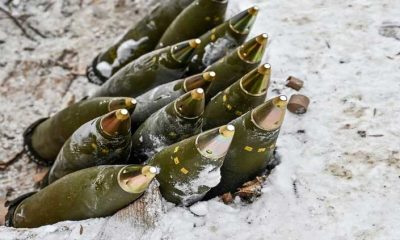The day after Russia invaded Ukraine, the leaders of NATO’s 30 member countries held an emergency summit to address what they described as the gravest threat to Euro-Atlantic security in decades — the launch of what would become the biggest land war in Europe since 1945.
“In this very evolving and difficult situation, it’s hard to predict what will (happen) in the future, but allies are providing support and are very committed to continue,” NATO Secretary-General Jens Stoltenberg told reporters. What that support might look like was an open question.
In the months that followed, Ukraine’s supporters at NATO and elsewhere sent fuel, helmets, medical supplies and other non-lethal support. Then, after much hand-wringing, came artillery and air defense systems in the hope that these would not provoke Russia’s President Vladimir Putin.
NATO, as an organization, was wary of being dragged into all-out war with nuclear-armed Russia. Technically it still is, but a year on the Ukraine Contact Defense Group this week held talks at NATO’s Brussels headquarters, where the alliance’s leaders, ministers and envoys usually sit.
Having just secured a promise of sorely needed battle tanks Ukraine wanted more: fighter jets.
“Ukraine has to win this war,” said Hanno Pevkur, the defense minister of Estonia, a Baltic country that shares a border and a long history with Russia and is extremely wary of Putin’s intentions. The government has stepped up conscription and NATO has boosted its troop presence there.
“We had many questions. Should we send tanks? Now this decision is made,” Pevkur said. “Always, there has been the question before, and then the answer after that. We know that Ukraine needs any kind of help, and that means also jet fighters.”
All that’s missing, it might seem, is the boots of allied troops on the ground. Indeed, the public in Europe and North America could be excused for believing that their taxes funding the world’s most powerful security organization are being spent in a war with Russia.
In the year since the Russians invaded, the U.S. has provided more than $27 billion in military help to Ukraine. Two senior defense officials estimated this week that other allies have stumped up more than $19 billion worth, with over $1 billion each from Britain, Canada, Germany, Italy, the Netherlands and Poland.
That’s on top of the tens of billions the West is sending to keep Ukraine’s battered economy afloat.
For the nationalist government of Hungary, a NATO ally, there is no doubt about what this means.
“If you send weapons, if you finance the entire annual budget of one of the belligerents, if you promise more and more weapons, more and more modern weapons, then you can say whatever you want. No matter what you say, you are in the war,” Prime Minister Viktor Orban said last month.
Not so, says Stoltenberg. Even as he exhorted allies and partners this week to give Ukraine more weapons and ammunition, the former Norwegian prime minister insisted, in response to a question from The Associated Press, that NATO is not at war with Russia.
“Neither NATO nor NATO allies are party to the conflict. What we do … is to provide support to Ukraine. Ukraine is defending itself,” he said. “The type of support that we provide to Ukraine has evolved as the war has evolved.”
Indeed it has, and some of it is tough to find despite the West’s best intentions. Ukraine now fires daily as many artillery shells as a small NATO country orders during a peace-time year, and Europe’s defense industry just can’t keep up.
“This has become a grinding war of attrition, and therefore it’s also a battle of logistics, and this is a huge effort by allies to actually get in the ammunition, the fuel, the spare parts which are needed,” Stoltenberg said.
Perhaps one of the most important changes sparked by the war has been the realization that NATO’s collective defense guarantee — the pledge that an attack on any ally will be met with a response from them all — is no longer an abstract promise.
Former U.S. President Donald Trump undermined confidence in that guarantee by threatening to abandon any ally that he considered was not spending enough on its armed forces.
Early in the war his successor, Joe Biden, vowed that NATO would defend “every inch” of its territory, to dissuade Putin from targeting any member. Finland and Sweden even gave up their traditional stance of non-alignment to apply to join NATO and secure that very protection.
One year on, some 40,000 troops are under NATO command in eastern Europe, from Estonia down to Bulgaria on the Black Sea. Around 100,000 U.S. troops are stationed in Europe. Some 140 warships ply European waters, aerial surveillance runs round the clock and a total 130 aircraft are on permanent standby.
Those forces are only meant to remain on allied territory but member countries near Russia’s borders, like Lithuania, say they are prepared to go “all the way” in their support for Ukraine. They believe the country should be permitted to join NATO, war or not.
When NATO leaders meet in the Lithuanian capital Vilnius in July they are likely to consider upping the ante with more hi-tech equipment. It’s hard to believe that any ally might ponder sending troops. But 18 months ago not even NATO believed that Putin would invade Ukraine.
Post Views: 162

 Fashion3 months ago
Fashion3 months ago
 Fashion3 months ago
Fashion3 months ago
 Sports3 months ago
Sports3 months ago
 Sports3 months ago
Sports3 months ago
 Sports2 months ago
Sports2 months ago
 Sports2 months ago
Sports2 months ago
 Fashion2 months ago
Fashion2 months ago























